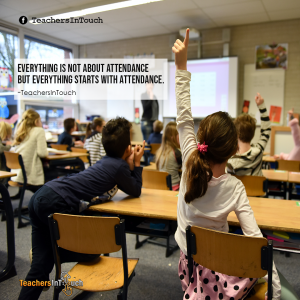How can I reach them and teach them if they are not in school?
Well, you can’t.
Everything is not about attendance but everything starts with attendance. Indeed, student attendance is a leading indicator for student achievement. If a student misses 10 days (excused or unexcused), he/she is facing major hurdles in mastering the course’s skill and content. We all agree that attendance is important. So why is it such a problem for schools to tackle?
School Attendance Mindset
First it is our mindset about school attendance. Many times we think of student attendance as a home issue. And since that is our perspective it hampers our efforts to improve attendance. I’m  quite sure you heard the saying that schools are operating the same way they did 50 years ago. This mindset on attendance proves that observation to be true. Unlike in the middle of the 20th century, education had a monopoly on mindshare for the surefire way to improve your lot in life. Now that is not the case. There is increasing competition for family’s minds on how they can improve including sports and entertainment to only name a few.
quite sure you heard the saying that schools are operating the same way they did 50 years ago. This mindset on attendance proves that observation to be true. Unlike in the middle of the 20th century, education had a monopoly on mindshare for the surefire way to improve your lot in life. Now that is not the case. There is increasing competition for family’s minds on how they can improve including sports and entertainment to only name a few.
Exhaustive Student Attendance Workflow
The second issue is that student attendance can be an exhaustive workflow. Teachers are already overwhelmed with large class sizes, tons of paperwork, changing standards, and so much more that they forget to complete the student absenteeism process. In addition to the main job of preparing and delivering a quality lesson, teachers have to take attendance, notify parents, send attendance letters, refer the student to the attendance committee which is comprised of more overworked and overwhelmed staff members, and document the aforementioned. And that is just the teacher. The counselor, parent, social worker, attendance clerk, assistant and others have to be involved. Each person has a workflow that has to be executed and documented. All to either get the student to attend or remove the student from the building. Imagine managing all of this while maintaining our focus on improving the teaching and learning of the students who are there.
Lack of a Plan For Student Absenteeism
A third school absenteeism problem are the reasons for student absenteeism and a lack of a comprehensive plan and subsequent implementation. We must understand why students are absent and develop and implement a plan to address those reasons. Some reasons include homelessness, lack of supplies or clean clothes, behavior, academic challenges, and not engaged in school. Many of these reasons are outside of the building. Who is responsible for discovering the reason for the absence? What partners do we have to help alleviate some of these issues? How are we developing curriculum and support systems within the school to engage students and inspire them to attend school and every class. Since most times administrators get the school keys without a playbook to improve school attendance, we don’t have a comprehensive plan to address student absenteeism. We need a plan that considers all factors and addresses the whole child.
 With distance or remote learning, we have to add a new dynamic. Students are not attending virtual school or classes nearly as much as they did regular school. Schools and students are struggling to adapt to this new reality. The attendance plan has to add a focus on virtual school attendance.
With distance or remote learning, we have to add a new dynamic. Students are not attending virtual school or classes nearly as much as they did regular school. Schools and students are struggling to adapt to this new reality. The attendance plan has to add a focus on virtual school attendance.
So back to the initial question, how can we reach them and teach them if they are not in school. Now that we have unpacked the problem. We can begin to properly address it. In future conversations, we will discuss control and influence. Please recognize that just because we may not be able to control something does not mean we are helpless in attacking it. When we can’t control something then influence is the next best thing. Improving student attendance largely falls under the influence category. Indeed leadership itself is about influence not control.
When it comes to attendance maybe we need to change The Serenity Prayer! What do you think?
We can change attendance. Here’s how!
Resources:
Tiered Intervention: A Comprehensive Attendance Approach, Los Angeles School District Pupil Services 2009
